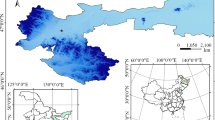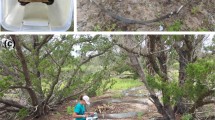Abstract
ON poor, acidified soils in The Netherlands, an increasing number of great tits, Parus major, and other forest passerines, produce eggs with thin and porous shells1. Here we show that the egg-shell defects, and the related high incidence of clutch desertion and empty nests, are caused by calcium deficiency, that snail shells are the main calcium source for the laying female, but that snails are scarce on poor soils. Similar laying irregularities in birds are reported from acidified regions elsewhere in Europe2–4. We provide evidence that snails declined by a decrease in soil calcium on poor soils. Acid deposition is the main cause for decreasing calcium levels in such soils5–7. To our knowledge, this is the first experimental evidence for calcium limitation in wild birds and it reveals a previously overlooked mechanism by which acidification affects higher trophic levels of the forest ecosystem.
Similar content being viewed by others
References
Drent, P. J. & Woldendorp, J. W. Nature 339, 431 (1989).
Carlsson, H. et al. Orn. Svecica 1, 51–53 (1991).
Schmidt, K.-H. J. Orn. 131, 172–174 (1990).
Winkel, W. & Hudde, H. Vogelwarte 35, 341–350 (1990).
Hanson, D. W. et al. Water Air Soil Pollut. 18, 227–239 (1990).
Tamm, C. O. & Hallbacken, L. Ambio 17, 56–61 (1988).
Ulrich, B. Z. Pflanzenernaehr. Bodenk. 149, 702–717 (1986).
Newton, I. & Bogan, J. Nature 249, 582–583 (1974).
Newton, I. Population Ecology of Raptors (Poyser, Berkhamsted, UK, 1979).
Opdam, P. J. et al. Ardea 75, 205–212 (1987).
Van Balen, J. H. Ardea 61, 1–93 (1973).
Wareborn, I. Ecography 15, 62–69 (1992).
Wareborn, I. Oikos 21, 285–291 (1970).
Crowell, H. H. Proc. Malac. Soc. Lond. 40, 491–503 (1973).
Ireland, M. P. Comp. Biochem. Physiol. A 98, 111–116 (1991).
Gärdenfors, U. Impact of Airborne Pollution on Terrestrial Invertebrates, with Particular Reference to Molluscs (Report 3362, National Swedish Environment Protection Board, Stockholm, 1986).
Heij, G. J. & Schneider, T. (eds). Acidification Research in The Netherlands (Final Rep. of the Dutch Priority Programme on Acidification, Elsevier, Amsterdam, 1991).
Ankney, C. D. & Scott, D. M. Auk 97, 684–696 (1980).
Schifferli, L. Ornith. Beob. 76, 289–292 (1979).
Creutz, G. Die Vogelwelt 74, 52–54 (1953).
Jones, P. J. Ibis 118, 575–576 (1976).
Schifferli, L. Ornithol. Beob. 74, 71–74 (1977).
Glooschenko, V. et al. Water Air Soil Pollut. 30, 553–567 (1986).
Graveland, J. Experientia 46, 962–970 (1990).
Ormerod, S. J. et al. Environ. Pollut. 55, 107–121 (1988).
Author information
Authors and Affiliations
Rights and permissions
About this article
Cite this article
Graveland, J., van der Wal, R., van Balen, J. et al. Poor reproduction in forest passerines from decline of snail abundance on acidified soils. Nature 368, 446–448 (1994). https://doi.org/10.1038/368446a0
Received:
Accepted:
Issue Date:
DOI: https://doi.org/10.1038/368446a0
- Springer Nature Limited
This article is cited by
-
Mid- and long-term responses of land snail communities to the intensification of mountain hay meadows management
BMC Ecology and Evolution (2022)
-
Characterization of the gut microbiome in wild rocky mountainsnails (Oreohelix strigosa)
Animal Microbiome (2021)
-
Preliminarily study on the maximum handling size, prey size and species selectivity of growth hormone transgenic and non-transgenic common carp Cyprinus carpio when foraging on gastropods
Journal of Oceanology and Limnology (2018)
-
Effects of calcium supplementation on growth and biochemistry in two passerine species breeding in a Ca-poor and metal-polluted area
Environmental Science and Pollution Research (2016)
-
Effects of environmental conditions on the egg mass, yolk antioxidant level, eggshell thickness and eggshell spotting patterns of Great Tits (Parus major)
Journal of Ornithology (2016)





